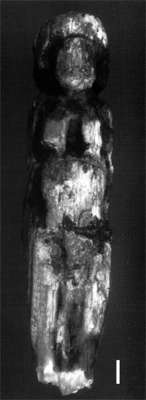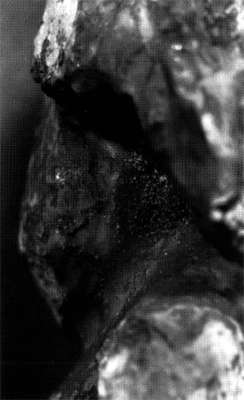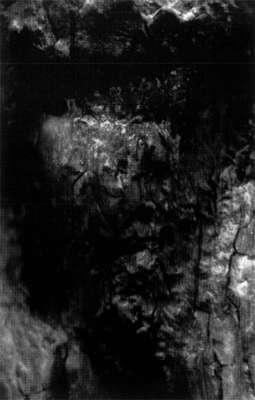Back to Don's Maps
Back to Venus figures from the Stone Age
Back to the Grimaldi - Balzi Rossi Venus figures
The Red Ochre Venus, or Dame ocree, is a venus of mammoth ivory from Balzi Rossi covered with red ochre
The Ivory figurine with red ochre or Dame ocree is a 7.52 cm tall female figurine made from mammoth ivory. The oval face has no facial features and the head and torso were originally covered with a very thick layer of red ochre. The hair forms a thick coiffure framing the face and tapering to two points that end on the backs of the shoulders, which may be interpreted as being braids. Although the upper arms are clearly carved at the sides of the figurine, there is no trace of forearms or hands. Although the breasts are oblong and in profile appear cylindrical, they do not rest on the round and protruding abdomen. The enlarged pubic triangle extends well forward of the plane of the thighs and lacks the indication of a vulva. The simplified legs taper but are also broken at the knees, making it impossible to tell if there ever were any legs below this point.![]() Figurine d'ivoire surnommée "La Dame Ocrée", des grottes dei Balzi
Rossi (Ligurie - Italie) - copyright Pierre Bolduc-Montréal-Canada.
Figurine d'ivoire surnommée "La Dame Ocrée", des grottes dei Balzi
Rossi (Ligurie - Italie) - copyright Pierre Bolduc-Montréal-Canada.
Figurine of ivory called "The Ochred Lady", from the caves of Balzi Rossi (Ligurie - Italy) - copyright Pierre Bolduc-Montreal-Canada.
The text below is adapted from
http://www.civilization.ca/archeo/paleofig/palf4fra.html
Called thus because of the ochre coating which colours its nonfaded surfaces, this statuette is located well inside the standards of the gravettienne statuary of Western Europe. One finds there the superabundance characteristic of the buttocks, breasts and belly. It seems that special attention was given by the artisan to the treatment of various parts of the body such as the hair which still carries the traces of fine corrugated lines. One can also note the marked cutting of the pubis which presents a not very common relief on the other statuettes from Balzi Rossi and France. Finally, a perforation has been hollowed out from the back to the sternum, indicating that this figurine was used as a pendant.
This statuette is 75 mm high.
Photo and French text: "les mammouths - Dossiers
Archéologie - n° 291 - Mars 2004"
My thanks to Anya for access to this resource.

Balzi Rossi or Grimaldi piece called the Ochred Lady, or Figurine en ivoire à l'ocre rouge
Photo: © Harry Foster

Another version of the Ochred Lady.
Photo: Cohen (2003)

Front view of the Ivory Figurine in Red Ochre (coll. Bolduc).
Scale : 5 mm.
Photo: R. White
Source: White et Bisson (1998)
It is a female figure made of a non-fossilised mammoth tusk (Fig. 7).
The lower limbs are partially broken, but the piece is relatively complete, although, because of its very friable surface, there is exfoliation on the back of the head, lower limbs and buttocks . There is evidence showing that it was covered with a protective diluted varnish in order to consolidate a large crack extending across the right side, an area of weakness due to the 'puff pastry' structure of the ivory.
The head and body of the statue were originally covered with a thick layer of red ochre (Fig. 8). The colour of the piece is between dark red and red-brown (Munsell = 2.5YR 2.5/2 to 5YR 3/4). The surface was also polished in the Paleolithic. Where the surface is exfoliated, the original color is white.
Text above: White et Bisson (1998)


Colours shown here are Munsell = 2.5YR 2/2, Dark grayish reddish brown (left) and 5YR 3/4 Brown red (right)
rgb equivalents (on the 0-255 scale) 66, 44, 42 and 102, 63, 45
Data from http://www.perbang.dk/
However, applying a protective varnish has created an ochre stain on the non-exfoliated areas, creating reddish zones. Other accidents are visible in this statue, like the loss of the tip of the left breast, and an area from the top of the upper arms to the bottom of the lower legs. There is a corrugated surface on the right leg as well as a break in the lower legs dating perhaps from the excavations. The piece measures 75.2 mm long.
The width of the head is 16.9 mm, the width at the level of the breasts is 12.9 mm, and the width of the hips is 18.4 mm. The maximum width of the piece, taken between the buttocks and the abdomen, is 21.6 mm. It weighs 1 995 g (? This seems to be a typo. Probably 19.95 grams - Don)
Text above: White et Bisson (1998)


(left) Profile of the head of the Ivory Figurine in Red Ochre highlighting the thick deposit of ochre. (coll. Bolduc).
(right) - Detail of the pubic triangle of the Ivory Figurine in Red Ochre showing the deep incisions and erosion of the surface (coll. Bolduc).
Photo: R. White
Source: White et Bisson (1998)
The head is erect and there are no lines on the oval face. The hair is clearly marked. The hair forms a thick hairstyle framing the face and ending in two sharp points on the back of the shoulders. The front and back of the hairstyle are separated by a series of incisions aligned end to end. The front carries no detail. The back, however, has vertical lines that appear to be hair. On the torso, the upper limbs are gone, but their outlines remain. They give the impression that the upper limbs were flexed.
The breasts are oblong in shape and appear cylindrical in profile. They do not rest on the abdomen. A deep groove separates the two breasts and extends to the hole at the base of the chest. This hole, carefully drilled, forms an angle with the axis of the piece. It piercers the figure from front to back and ends higher at the back in a large conical hole. Red ochre is in this hole, suggesting an application of the ochre in a liquid form.
The abdomen is round in shape and more prominent than the chest. The pubic triangle is bounded by three large incisions (Fig. 9). Its shape is a pronounced bulge, with a slightly conical profile and tapering towards the bottom.
Its surface is in too poor a condition to allow many other observations. The vulva is not indicated. The hips are wide. The buttocks are protruding, hemispherical and lack a groove of separation. The lower limbs are schematic and slender in profile, and concave when viewed from behind.
Text above: White et Bisson (1998)
The 'ivory figurine with red ochre' or 'Dame ocrée' is a 7.52 cm tall female figurine made from ivory. The oval face has no facial features and the 'head and torso were originally covered with a very thick layer of red ochre'. The hair forms a thick coiffure framing the face and tapering to two points that end on the backs of the shoulders, which may be interpreted as being braids. Although the upper arms are clearly carved at the sides of the figurine, there is no trace of forearms or hands. Although the breasts are oblong and in profile appear cylindrical, they do not rest on the round and protruding abdomen. The enlarged pubic triangle extends well forward of the plane of the thighs and lacks the indication of a vulva. The simplified legs taper but are also broken at the knees, making it impossible to tell if there ever were any legs below this point.
Text above: Jennett (2008)
References
- Cohen C., 2003: La femme des origines. Images de la femme dans la préhistoire occidentale,, Paris, Belin-Herscher, 2003, 191 pages.
- Jennett K., 2008: "Female Figurines of the Upper Paleolithic" (2008), University Honors Program Paper 74. http://ecommons.txstate.edu/honorprog/74
- White, R., Bisson M., 1998: Imagerie féminine du Paléolithique : l'apport des nouvelles statuettes de Grimaldi, Gallia préhistoire. Tome 40, 1998. pp. 95-132.